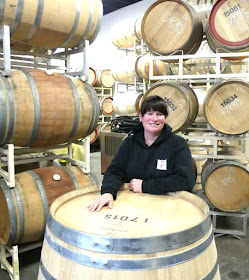Photo: Jessie (left) and Randy Toor
Along with its peers, Desert Hill
Estate Winery has begun releasing wines from the 2018 vintage.
“They are fantastic,” suggests winemaker Anthony Buchanan. “It was
a real good vintage. Everything turned out well. There is lots of acidity and
the wines are very well balanced.”
A recent tasting with him and Desert Hill’s principals confirmed
that assessment. It also confirmed that the winemaking talents of Anthony, who
has been at Desert Hills since late 2015, have raised the bar at this
well-established winery on Black Sage Road.
The winery, which opened in 2003, is operated by twins Randy (the
winery president) and Jessie Toor, born in 1964 in Punjab, brother Dave and
Randy’s son, Rajen, who is becoming a winemaker.
The
Toor family initially purchased an apple orchard on Black Sage Road in 1988,
which they converted to vineyard in 1995. Today, they own five vineyards
totalling 85 acres. They sell some of their production while making 12,000
cases a year for Desert Hills.
Anthony (left) once operated a Victoria hair salon before switching careers
in 2010. Trained in winemaking and viticulture at Washington State University,
he previously worked at Church & State Winery and Eau Vivre Winery &
Vineyard before joining Desert Hills. He also produces small lots for his own
boutique label, Anthony Buchanan Wines.
The impact he is having at Desert Hills ranges from innovations in
the cellar to drier finishes on such whites as Gewürztraminer. This year, the
winery is purchasing a concrete kvevri, a fermentation vessel based on the
designs used for winemaking on Georgia. One object is to enhance the texture of
the wines.
He has also tweaked the style of the Desert Hills Gamay Noir, the
red for which the winery already has a stellar reputation. In Anthony’s view,
previous vintages were too big due to practises in the vineyards.
“I found the wine too extracted and too ripe, too high in alcohol,”
Anthony says. “The fruit profiles have been really nice but they have been too
bold. To me, that is not Gamay.”
By picking the fruit a little earlier and by taking significant extra
pains with the winemaking, he has achieved a more elegant wine.
“What happens is you get this fruit-driven, nicely balanced wine,”
he says. “It has all the Gamay characteristics without being that light nouveau
style. It expresses the fruit and the terroir. It has good acidity. That has
been the focus – to bring it back to a Gamay style of wine while still keeping
our customers happy.”
Here are notes on current releases from Desert Hills.
Desert Hills Pinot Gris 2018 ($21.90). This is a wine with remarkable purity of fruit,
both in the aroma and on the palate. There are aromas and flavours of apple and
citrus. The texture is generous and the finish persists. 91.
Desert Hills Unoaked Chardonnay 2018 ($19.90). This is a crisp wine with aromas and flavours of
apple. There is a pleasant mineral note on the finish. 90.
Desert Hills Cactus White 2018 ($17.90). This successful blend has been in the winery’s
portfolio for almost a decade. The blend for this vintage is Gewürztraminer,
Viognier, Chardonnay, Sauvignon Blanc and Pinot Gris. It begins with spicy
aromas leading to a medley of fruit flavours, including lychee and honeydew
melon. It is balanced to finish dry. 91.
Desert Hills Viognier 2018
($24.90). This is a wine with aromas of apricot and peach. Stone fruit flavours
dominate the honeyed richness of the palate. The finish is persistent. This is
a superior South Okanagan Viognier. 93.
Desert Hills Gewürztraminer 2018 ($23.90). Here is a good dry Gewürztraminer with spice and
ginger and lychee on the nose and palate. 91.
Desert Hills Helena Rose 2018 ($21.90). The blend is 66% Merlot, 34% Gamay Noir. The wine
presents in the glass with an appealing pink hue. It has aromas and flavours of
strawberry, cranberry, watermelon and rhubarb. The bright natural acidity makes
the wine crisp and refreshing. 91.
Desert Hills Gamay Noir 2018 ($22.90). This fruit driven wine has aromas and flavours of
cherry and plum. The texture is fresh with bright acidity. There is a spicy
note on the finish. 91.
Desert Hills Merlot 2015 ($24.90).
The wine has aromas of black cherry and cassis mingled with a hint of smoke.
The earthy finish gives the wine a rustic personality. 89.
Desert Hills Cabernet Franc Reserve 2015 ($28.90). This is an intense and full-bodied wine with
aromas of black cherry and blackberry. These are echoed on the rich and brambly
palate. 93.
Desert Hills 2014 Syrah 2014 ($36.90). This is a classic full-bodied Syrah, with aromas
of pepper and deli meats. The palate mingles meaty notes with figs, dark fruits
and black pepper. 92.
Desert Hills Mirage 2014
($36.90). This is the winery’s iconic red. It is a blend of 45% Cabernet
Sauvignon, 30% Cabernet Franc, 10% each of Malbec and Petit Verdot and 5% of
Syrah. This is a rich and satisfying wine with aromas of black cherry, plum and
spice, echoed on the palate. The blend was put together by Anthony Buchanan
who, for the first time, added Syrah to Mirage. It was a great idea. 94.










































